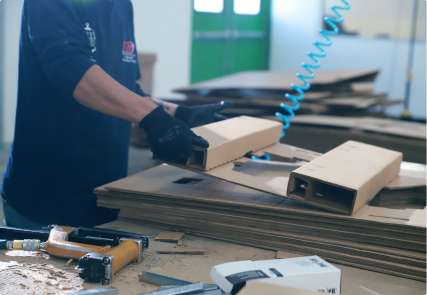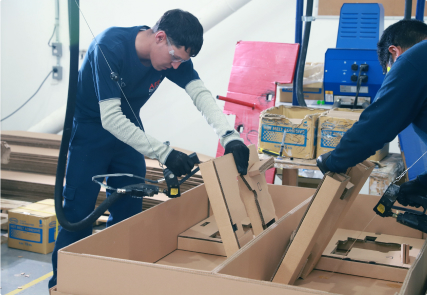Expendable packaging is ideal for most domestic and overseas shipments. Our innovative designs work efficiently within road trailers and sea containers to protect your products throughout the supply chain.




In-house program management that ensures customers timelines and budgets are met.
Innovative designs that efficiently cube-out over road trailers and sea containers.
Over twenty-five proven engineers with experience exceeding 15+ years offer the experience you need to get the job done right.
From inbound material inspections through HT-ITSPM lumber, our ISTA, ISO 9001, manufacturing ensures a quality product every time.
We support the just-in-time manufacturing processes of our customers and get the right solutions delivered to the right place, at the right time.
Got a challenge or issue – just pick up the phone and we’ll be there for you.

100% recyclable cardboard
EcoVadis 71st Percentile
In-House Foam Recycling
Environmentally friendly reusable containers are cost efficient and provide superior performance and return on investment. Recycle reusable container systems at the end-of-life to reduce carbon emissions.


ABP started as a supplier to Detroit’s auto industry and we’ve expanded to support many different customers and industries
Operations in US and Mexico and integrated partnerships throughout Europe and Asia
Expendable packaging is any type of packaging material that is intended to be used only once and then discarded or disposed. This type of packaging includes items such as cardboard boxes, plastic bags, and paper wrapping that are used to protect and transport products from one place to another. Expendable packaging is typically designed to be inexpensive, lightweight, and easy to dispose.
Expendable packaging can be made from a variety of materials, depending on the specific needs and requirements of the product being packaged. Some common materials used include:
Expendable packaging offers several benefits, including:
Protection: Designed to protect products during transportation and storage. It can help prevent damage or breakage, ensuring that products arrive at their destination in good condition.
Convenience: Easy to use and can be quickly assembled and disassembled. It is also lightweight, making it easy to handle and transport.
Cost-effective: Typically less expensive than reusable packaging options, such as pallets or crates. This can help reduce costs for businesses that need to ship or store large quantities of products.
Customization: Can be customized to fit the specific needs of the product being shipped or stored. This includes size, shape, and materials used.
Hygiene: Can help maintain hygiene and prevent contamination during transportation and storage. This is particularly important for food and medical products.
Sustainability: While not all expendable packaging is sustainable, many materials used can be recycled or biodegraded, reducing their impact on the environment. Some newer options are also made from renewable resources.
Overall, expendable packaging can be a practical and effective solution for businesses looking to transport or store products in a safe and cost-effective manner.
Examples of an expendable packaging include corrugated cartons, corrugated roll-ups, die cut foam, hexacomb die cuts / blocks, and cardboard boxes.
Cardboard boxes are widely used for shipping and storage because they are lightweight, easy to assemble, and can be customized to fit the specific needs of the product being shipped. They are also relatively inexpensive and can be recycled, making them a more sustainable option compared to other materials such as plastic. Once the box is used to transport the product, it can be broken down and recycled, making it an example of a disposable packaging solution.
The main difference between expendable and returnable packaging are their intended lifespan and reuse.
Returnable packaging is designed to be used multiple times, whereas expendable is intended to be used once and then discarded. Returnable packaging can include items such as plastic crates, pallets, and reusable containers. These materials are typically more durable and sturdier than expendable packaging and are designed to withstand multiple trips through the supply chain. After each use, they are cleaned and maintained before being reused again.
Expendable packaging, on the other hand, is designed for one-time use only. This includes items such as cardboard boxes, paper wrapping, and plastic bags. Expendable is often less expensive than returnable packaging and is more suitable for one-time shipments or for products that do not require repeated transportation.